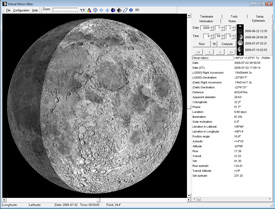
You can enjoy viewing the Moon with nothing more than a modest telescope equipped with a few eyepieces. Even binoculars can show a great deal. But to get the most out of your lunar explorations a few additional tools are a big help. Here are my picks of the best and most essential Moon goodies.

Best Moon Book: There are lots of books about the Moon, but only one successfully combines a deep understanding of lunar geology with a backyard astronomer’s perspective. Charles A. Wood’s excellent The Modern Moon: A Personal View is easily the finest. Chuck’s book not only describes what there is to see, he also writes about what it all means and why features look the way they do. A working lunar scientist, Chuck has an insider’s perspective on the field, yet never loses sight of the book’s audience.
In 19 chapters, Chuck takes you on a guided tour of maria, craters, and a host of other formation — all described with crisp, accessible prose. A must have.

Best Moon Map or Atlas: A year ago, the hands down winner would have been Antonín Rükl’s classic Atlas of the Moon. Sadly, this fine volume is momentarily out of print. If iyou can snag a used copy at a reasonable price, do so — you won’t find a more usable lunar atlas. The Moon is depicted in 76 exquisitely detailed charts and each one is a work of art.
Although not as detailed as Atlas of the Moon, Rükl’s Field Map of the Moon is an excellent 2nd choice for navigating the lunar surface. Certainly, when used at the telescope, Field Map actually has some important advantages. For one thing, it divides the Moon up into only four sections, which makes it easier to see the relationship between individual features and regions. Secondly, the map folds and unfolds in such a way that you can view a single quadrant, pair of quadrants, or the whole lunar disk. It’s also available in a mirror-reversed version
for those with telescopes equipped with star diagonals.

Best Lunar Software: A printed chart or atlas has one serious limitation: it can’t show the Moon dynamically as it appears at a given moment. The great advantage of computer software is that it can portray the Moon’s disk with the correct phase and libration angle taken into account. And the best software is Christian Legrand and Patrick Chevalley’s Virtual Moon Atlas. This is a wonderful piece of work that you can spend a lot of time playing around with. Indeed, it does so much that it’s probably a good idea to start off with the “light” version before taking on the more advanced “expert” and ‘pro” editions. Fast, accurate, and full-featured — what more could you want? How about “free” too. That’s right: it’s freeware. So what are you waiting for? Download it here.
For more information on these and other books and charts, check out the My Books + page.
Did you find this article interesting or helpful? If so, consider using this link the next time you shop at Amazon.com. Better yet, bookmark it for future use. Thanks to Amazon’s associates program, doing so costs you nothing yet helps keep this site up and running. Thanks!
